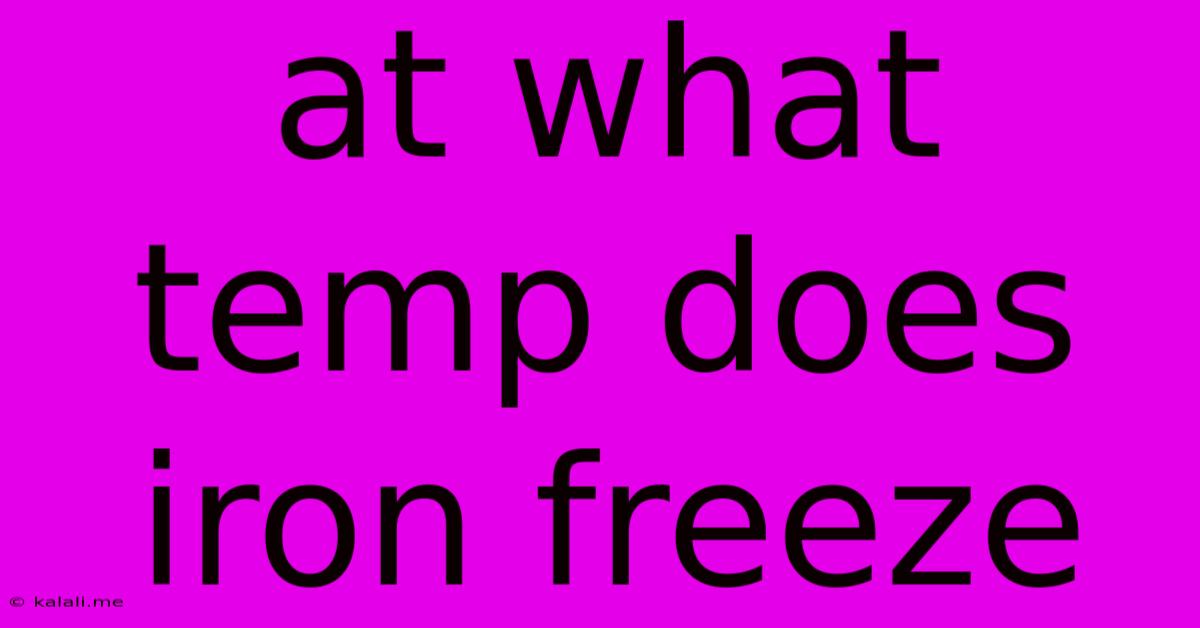At What Temp Does Iron Freeze
Kalali
Jun 04, 2025 · 3 min read

Table of Contents
At What Temperature Does Iron Freeze? Understanding the Freezing Point of Iron
Iron, a ubiquitous metal essential to our modern world, boasts a fascinating array of properties. One often-overlooked characteristic is its freezing point – the temperature at which liquid iron solidifies into a solid. This article delves into the specifics of iron's freezing point, exploring the factors influencing it and the scientific principles involved.
What is the Freezing Point of Iron?
The freezing point of iron isn't a simple, single number. It depends significantly on the purity of the iron and the pressure exerted upon it. However, under standard atmospheric pressure (1 atm), pure iron freezes at approximately 1538°C (2800°F). This transition from liquid to solid is known as solidification or crystallization.
Factors Affecting Iron's Freezing Point
Several factors can influence the precise freezing temperature of iron:
-
Purity: Impurities in the iron, such as carbon, silicon, manganese, or other alloying elements, significantly lower its freezing point. This is why the freezing point of cast iron, for example, which contains carbon, is different from that of pure iron. Steel, another iron alloy, also exhibits a different freezing point compared to pure iron.
-
Pressure: Pressure also plays a role. While the effect isn't as dramatic as with some substances, increased pressure can slightly alter the freezing point. At extremely high pressures, the phase diagram of iron becomes considerably more complex, with multiple solid phases exhibiting different crystal structures.
-
Cooling Rate: The speed at which liquid iron cools affects the formation of crystals and can influence the final structure of the solid iron. A rapid cooling rate can lead to smaller crystals and different material properties.
The Science Behind Iron's Freezing Point
The freezing point of any substance is determined by its atomic structure and the intermolecular forces between its atoms. In the case of iron, the strong metallic bonds between iron atoms dictate its high melting and freezing points. As liquid iron cools, its atoms lose kinetic energy, allowing them to arrange themselves into a more ordered crystalline structure (typically a body-centered cubic structure at lower temperatures, transitioning to a face-centered cubic structure at higher temperatures). This transition releases latent heat.
Applications and Implications
Understanding iron's freezing point is crucial in various applications, including:
-
Metallurgy: Precise temperature control during steel and iron manufacturing is essential to achieve the desired properties in the final product. The freezing point acts as a critical parameter in controlling the casting and solidification processes.
-
Welding: Welders need to understand the melting and freezing points of the metals they are working with to avoid defects and ensure a strong joint.
-
Geophysics: The freezing point of iron is relevant to understanding the Earth's core, which is believed to consist largely of a molten iron-nickel alloy.
Conclusion
While the commonly cited freezing point of iron is 1538°C, remember that this value is for pure iron under standard pressure. The actual freezing temperature can vary based on factors such as impurities and pressure. This understanding is fundamental to various scientific and engineering disciplines. Understanding the intricacies of this seemingly simple characteristic unlocks a deeper appreciation for the complex behavior of this essential metal.
Latest Posts
Latest Posts
-
How Long Does Meat Sauce Last In The Fridge
Jun 06, 2025
-
Caulk Or Grout Between Tub And Tile
Jun 06, 2025
-
How Does A Bathtub Drain Work
Jun 06, 2025
-
Do Endermites Spawn In The Nether
Jun 06, 2025
-
How To Compute Correlation Of 2 Dimensions 4 Numbers
Jun 06, 2025
Related Post
Thank you for visiting our website which covers about At What Temp Does Iron Freeze . We hope the information provided has been useful to you. Feel free to contact us if you have any questions or need further assistance. See you next time and don't miss to bookmark.